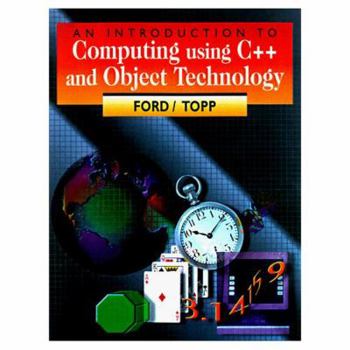An Introduction to Computing Using C++ and Object Technology
Successful authors William Ford and William Topp have written the first introductory programming book using C++ that concentrates on teaching object design. The authors recognize that program design... This description may be from another edition of this product.
Format:Paperback
Language:English
ISBN:0132681528
ISBN13:9780132681520
Release Date:September 1998
Publisher:Pearson
Length:811 Pages
Weight:2.77 lbs.
Dimensions:1.3" x 7.0" x 9.2"
Customer Reviews
2 ratings
Good for learing, even better for reference
Published by Thriftbooks.com User , 23 years ago
If you want to learn C++, this is the book. It covers the areas very well, perfect examples, and brilliant syntax definitions. If you learn the metods in the book, you will have a nice clean coding habit, which will be of good use at any time. The CD-Rom that comes with the book is not of great use (if any at all), but never the less, this book covers all of the basic areas giving the reader a insight into all aspects WITHOUT confusing him. Once you have learned C++, it is a VERY good book to use for reference.
Excellent book showing a consistant, thoughtout approach.
Published by Thriftbooks.com User , 25 years ago
This is a very good text book for learning the fundamentals of C++ programming. It is well thought out and consistent with worked examples that are developed throughout the book. It offers the student the opportunity to work through a lot of material and this is essential for becoming confident at using C++ concepts and syntax. What is particularly interesting about this book is the way that analysis is applied to different problems as it is frequently the most difficult step of all to see a problem in terms of a possible programming solution. Continually repeating these steps is the only way to begin to see how to breakdown problems so that they become amenable to solution. The diagrams in the text also show the same thought and care and are genuinely useful. I am grateful to the authors for the effort and thought that has gone into this work. However, there are a couple of places where perhaps two or three lines of additional text explanation would help, such as in the Tower of Hanoi solution. What I am thinking about here is the general principal of using variables passed by constant reference in the solution. One needs a general handle on why/how this works so successfully. There may be one or two other places in the text where this also applies. Another interesting point is that this text can be used with considerable success without access to a computer! This may seem like a strange comment, but where I teach not everyone does have consistent access to a computer in the facilities of the University nor can they, necessarily, afford a computer of their own. Sometimes an inconsistent resource is worse than just using paper and pencil! However, where systems, or your own PC, work properly the CD resource makes this book particularly good value. My only disappointment is that Prentice Hall have not followed up with the instructors manual to the original promised deadline.




